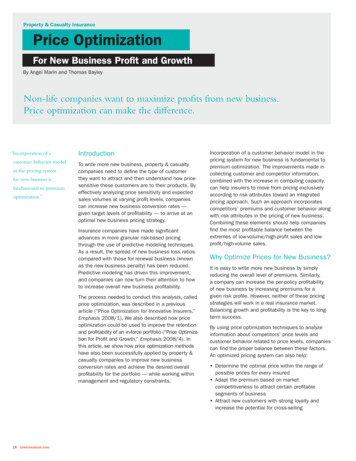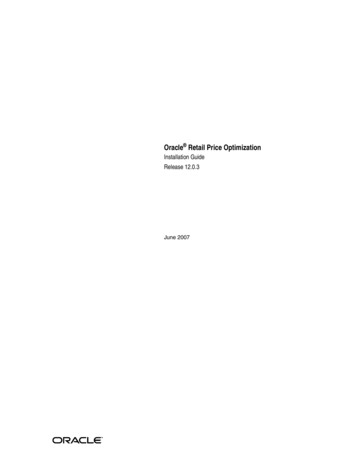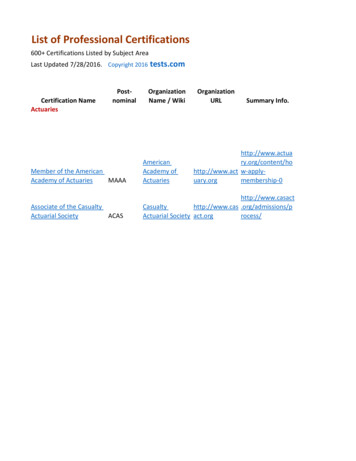
Transcription
Property & Casualty InsurancePrice OptimizationFor New Business Profit and GrowthBy Angel Marin and Thomas BayleyNon-life companies want to maximize profits from new business.Price optimization can make the difference.“ Incorporation of acustomer behavior modelin the pricing systemfor new business isfundamental to premiumoptimization.”18 towerswatson.comIntroductionTo write more new business, property & casualtycompanies need to define the type of customerthey want to attract and then understand how pricesensitive these customers are to their products. Byeffectively analyzing price sensitivity and expectedsales volumes at varying profit levels, companiescan increase new business conversion rates —given target levels of profitability — to arrive at anoptimal new business pricing strategy.Incorporation of a customer behavior model in thepricing system for new business is fundamental topremium optimization. The improvements made incollecting customer and competitor information,combined with the increase in computing capacity,can help insurers to move from pricing exclusivelyaccording to risk attributes toward an integratedpricing approach. Such an approach incorporatescompetitors’ premiums and customer behavior alongwith risk attributes in the pricing of new business.Combining these elements should help companiesfind the most profitable balance between theextremes of low-volume/high-profit sales and lowprofit/high-volume sales.Insurance companies have made significantadvances in more granular risk-based pricingthrough the use of predictive modeling techniques.As a result, the spread of new business loss ratioscompared with those for renewal business (knownas the new business penalty) has been reduced.Predictive modeling has driven this improvement,and companies can now turn their attention to howto increase overall new business profitability.Why Optimize Prices for New Business?The process needed to conduct this analysis, calledprice optimization, was described in a previousarticle (“Price Optimization for Innovative Insurers,”Emphasis 2008/1). We also described how priceoptimization could be used to improve the retentionand profitability of an in-force portfolio (“Price Optimization for Profit and Growth,” Emphasis 2008/4). Inthis article, we show how price optimization methodshave also been successfully applied by property &casualty companies to improve new businessconversion rates and achieve the desired overallprofitability for the portfolio — while working withinmanagement and regulatory constraints.By using price optimization techniques to analyzeinformation about competitors’ price levels andcustomer behavior related to price levels, companiescan find the proper balance between these factors.An optimized pricing system can also help:It is easy to write more new business by simplyreducing the overall level of premiums. Similarly,a company can increase the per-policy profitabilityof new business by increasing premiums for agiven risk profile. However, neither of these pricingstrategies will work in a real insurance market.Balancing growth and profitability is the key to longterm success. Determine the optimal price within the range ofpossible prices for every insured Adapt the premium based on marketcompetitiveness to attract certain profitablesegments of business Attract new customers with strong loyalty andincrease the potential for cross-selling
Development of the pricing system should considernot only the risk but also the variation of otheracquisition costs, customers’ sensitivity to productprice (elasticity), and the likelihood of their buyingother products (cross-selling) or staying longer withthe company. To address these issues, companies need to startby defining a “benefit function” that incorporatesthe primary elements of product profitability overthe required time horizon. The goal of the priceoptimization process is to find the premium levelthat will maximize this benefit function. Figure 1shows a typical breakdown of this function. To arrive at a benefit function model, the followingitems will need to be included: Conversion rate model. This model estimates theprobability of writing a new policy considering therelevant variables related to the customer andmarket competitiveness. Proposed premium to be offered to thepotential insured. This is what the optimizationprocess essentially solves for. This proposedpremium is calculated by taking into account theappropriate probability of discounts such as No Claims Discount in the U.K. or Bonus-Malus inContinental Europe.Model refinement. These models are usuallyrefined by incorporating the probability that thepolicyholder remains with the company over time,and may also take into account extra profit arisingfrom cross-selling and referrals (both of which canbe modeled probabilistically).Benefit function. In particular, this can bemodeled using time horizons chosen according tothe financial goals of the company. It can be builtfor a short-term time horizon, such as one year, orfor a longer time period of three to five years.Pure premium model. This can be carried out bymodeling frequency and severity separately, orcan be done directly through the modeling of losscosts, adjusted for inflation and loss development.Expenses. All expenses must be considered,including those for acquisition, administration andclaim handling (perhaps varying by client profile).Expenses can be modeled both at the portfolioand per-policy levels.Angel MarinSpecializes in pricingand reserve reviewsupport for P&C insurers.Towers Watson, MadridThomas BayleySpecializes in reservereview and pricingsupport for P&Ccompanies.Towers Watson,PhiladelphiaFigure 1. Structure of a benefit function for new business price optimizationMaximize Benefit Function.Benefitfunction es)Emphasis 2010/1 19
Some of the most important variables used inmodeling these components are the classification ofagents, driver age, claim history, geographical areaor territory, Bonus-Malus system (or equivalent claimdiscount/surcharge system), and the differencebetween the offered and the market premium.Building a Price Optimization Modelfor New BusinessElasticity of demand is a key ingredient in thisprocess. Each company has its own elasticity-ofdemand curve (formed by its potential client profiles,each with its own behavior). The curve is based onan analysis of the relationship between changes inthe incremental quantities of policies converted frominitial quotations and the price increase or decreaseproposed by the company.Figure 2. Comparison of discount profitability and conversion ratein a European auto marketDifference in premium offered by the company vs. market premium70%Discount probabilityConversion rate30%25%60%50%20%40%Conversion rate15%30%10%20%5%10%0%0%Below the marketAbove the marketFigure 3. The optimization model· Pure premiums· Financial objectives· Conversion rate model· Cross-selling effects· Competitors’ ratesInput20 towerswatson.comOptimizationIndividual premiums, optimizedin accord with the demandfunction and financial goalsof the companyStatistical toolsOutputDiscount probability35%To ensure that the model represents current marketreality, the internal and external data must becontinually tested and upgraded. A model basedon market information even just a year old may notaccurately reflect current market competitiveness,and its use can lead to unprofitable pricingdecisions.Competitive market analysis (CMA) enables insurersto obtain premium rates for as many risks andcompetitors as possible (see “Competitive MarketAnalysis in Personal Lines,” Emphasis 2007/2).CMA incorporates the insight and knowledge ofgeneral market behavior (market direction, keycompetition), knowledge of price levels by ratingfactors, intensity of the competition by segment(measure of price dispersion) and a comparisonof the company’s prices against market prices bysegment.“The classic approach, whichcalculates premiums based solelyon loss costs, is not enough tooptimize a company’s growthand profits from new business.”Figure 2 shows a real example from a Europeanauto insurance market that gives policyholders ratediscounts for various reasons. The price elasticitymodel needs to take this discounting into account.The figure shows two direct relationships: first,between the conversion rate and the differencebetween the premium offered by the company andthe market premium for the relevant segment,and second, between the probability of applyingdiscounts to a new policy and the company/marketpremium differential. It is clear that: The lower the premium offered by the company incomparison with the market premium, the higherthe conversion rate and vice versa. The lower the premium offered by the company incomparison with the market premium, the lowerthe probability of the client being given a discount. The higher the premium offered by the company incomparison with the market premium, the higherthe probability of the client being given a discount.
Along with the price elasticity information, otherdata are needed to build the model, including purepremiums by class of business, financial goals ofthe insurer, cross-selling information and competitorprices by class.Figure 3 shows the inputs necessary for the newbusiness optimization model and the outputs thatwould be generated.Figure 4 is a schematic of the optimization processfor new business. At the start, the company needsto determine the constraint and the target. It ispossible to define the total new business revenueand maximize profitability given that revenue or(more commonly) to define the overall new businessprofitability and maximize new business revenuegiven that profitability target. The choice betweenthese two approaches is a key management input.The new business optimization process calls for anappropriate software tool that can jointly analyze allthe elasticity-of-demand functions for all potentialclients’ profiles. With this analysis, the companycan determine probabilistically the best combinationof conversion rates and types of client, and thenproduce the desired maximum (the number of newbusiness conversions) given an overall profitabilitytarget. The process may need to incorporateconstraints to satisfy any management or regulatoryrestrictions, which will lead to an adjusted anddefinitive combination of prices and client profiles.“ Balancing growth andprofitability is the key tolong-term success.”Results Obtained From the PriceOptimization ModelThe new business optimization process producesan efficient frontier where, for each conversion rate,there is a combination of policies and prices thatproduces different profitability levels. However, onlyone combination of policies and prices will give themaximum profitability for a given overall conversionrate. The graph of the maximum profitability for eachoverall conversion rate forms an efficient frontier.There are other suboptimal combinations for thesame conversion rate level, but the profitability willbe lower.A company might also want to maximize therevenue of new business, maintaining a given levelof profitability. In that case, management woulddetermine the overall profitability (in whatever formthis is defined) to be achieved by the new business,and the optimization process would produce thecombination of client profiles and individual pricesto achieve it (i.e., maximum number of new policiesor highest possible conversion rate), allowing for anyrestrictions.Figure 4. New business optimization processConversion rate modelTo estimate the probabilitythat the insured X acceptsa policy at a price Pconsidering market price QNewbusinessSimulationAppliedpremiumsProfitability functionTo estimate the profitabilityif the insured X accepts theprice P: Premium P- Expected pure premium- Internal expenses- Acquisition expensesInitial target:ProfitabilityTotal benefitfunctionGoal seekOptimizationEmphasis 2010/1 21
Figure 5 shows an example of an efficient frontierfor new business conversion. The current Company strategy (red dot) is clearlysuboptimal. The green dot represents Strategy 1, where thecompany improves profitability while maintainingthe same conversion rate. The orange dot represents Strategy 2, wherethe company improves profitability at a reducedconversion rate. The blue dot represents Strategy 3, where thecompany increases conversion rates whilemaintaining the same profitability level.Figure 5. Efficient frontier for new business conversion28.7528.60Conversion rateIncrease conversion rate/keep expected profit28.45Keep conversion rate/improve expected profit28.3028.15The optimal price for new business will be the onethat satisfies the company’s strategic objectiveswhile maximizing profitability, subject to managementand regulatory constraints. Optimized rates can beimplemented in two different ways: As an algorithm that calculates the optimizedprice per individual customer based on his/herparticular rating attributes, which can be built intothe rating structure and operate in real time As a set of optimized premium rates that would fitinto a tabular rating structureAdvantages of Adopting PriceOptimization of New BusinessReduce conversion rate/improve expected profit27.8527.700.00%Expected ProfitStrategy 2Strategy 33.40%9.18%Company strategy12.09%Efficient frontierFigure 6. Financial indicators for efficient frontier itNumberof policiesWrittenpremiums(thousands)Company strategy28.2%3340.0%146,20848,779Strategy 128.2%3373.4%146,20849,201Strategy 228.0%3439.2%144,92549,767Strategy 328.5%3320.0%146,93248,833Scenarios22 towerswatson.comImplementing OptimizedNew Business RatesCompany strategy28.00Strategy 1“By adopting price optimization early, pioneering companies will capture more ofthe new business that theydesire at profitable rates.”The classic approach, which calculates premiumsbased solely on loss costs, is not enough tooptimize a company’s growth and profits from newbusiness. The combined analysis of the differentindicators that affect profitability allows insurers toreach their financial objectives while maintaining acompetitive market position — thereby maintainingflexibility in the face of cyclical changes.The statistical techniques and models needed forthis analysis are available but are not yet widelyused, although they are rapidly gaining adherentsin different markets. By adopting price optimizationearly, pioneering companies will capture more of thenew business that they desire at profitable rates —and gain significant competitive advantage.For comments or questions, call or e-mailAngel Marin at 34 1 590 3009,angel.marin@towerswatson.com; orThomas Bayley at 1 215 246 7376,thomas.bayley@towerswatson.com.
article ("Price Optimization for Innovative Insurers," Emphasis 2008/1). We also described how price optimization could be used to improve the retention and profi tability of an in-force portfolio ("Price Optimiza-tion for Profi t and Growth," Emphasis 2008/4). In this article, we show how price optimization methods










